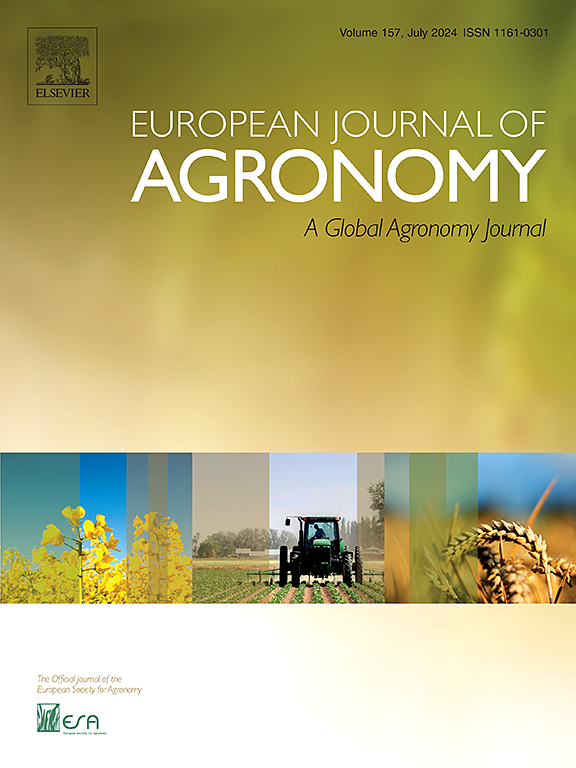1-氨基环丙烷-1-羧酸(ACC)在智利条件下对苹果减薄的效果
IF 5.5
1区 农林科学
Q1 AGRONOMY
引用次数: 0
摘要
在智利,苹果树的果实通常很高:每串果实约2.0-2.5个;因此,需要强有力的化学稀释策略来避免或减少手部稀释。1-氨基环丙烷-1-羧酸(ACC;Accede®)是一种乙烯前体,已被注册为不同水果作物的花或果实稀释剂,但必须根据物种、栽培品种和天气条件进行验证。本研究的目的是(i)评估从开花到“救援”处理的时间,在季节后期,ACC浓度的有效性,以及(ii)评估其作为商业化学稀释计划(CCTP)的一部分。《Brookfield Gala》和《Fuji Raku Raku》在四季中分别进行了6次和5次试播。在不同的季节和品种中,ACC单独或作为CCTP的一部分,以剂量-时刻-品种依赖的方式减少坐果。对于‘Gala’来说,ACC(224和448 mg L−1)对疏花非常有效,相当于12 mg L−1的NAA的效果。从花瓣掉落到果实直径为10-12 mm, 448 mg L−1的还原坐果;当果实长至18 ~ 25 mm时,需要更高的浓度(672 mg L−1)。在同一时期,672 mg L−1或更高浓度的辅剂或油表现出轻微到中度的落叶,这取决于季节。400 mg L−1乙烯利稀释效果与所有ACC浓度(448-672 mg L−1)在25 mm处相似;但其单果重和产量均低于ACC处理。富士需要较高的ACC浓度;672 mg L−1在盛花期将果实数量从2.5个减少到1.5个/簇,这被认为对“富士”有很好的效果。在4 毫米至10-12 毫米直径的果实之间,在良好的间伐天气条件下(即预计碳水化合物可用性较低),448-672 毫克 L−1减少了坐果量,但在“恶劣”的间伐条件下(即寒冷的夜晚和炎热的晴天),坐果量没有减少。在“补救”处理中也观察到类似的结果,当只有896 mg L−1使坐果减少到目标坐果(0.8-1.0个果实/簇)时,而中剂量(448-672 mg L−1)加辅助剂产生中等疏化效果,但仅在有利的天气条件下。综上所述,ACC是一种很有前途的苹果全开花稀释剂,也是苹果的“救援”稀释剂,特别是在18-25 mm阶段,其他稀释剂无效。本文章由计算机程序翻译,如有差异,请以英文原文为准。
The efficacy of 1-aminocyclopropane-1-carboxylic acid (ACC) in thinning apples under Chilean conditions
In Chile, apple trees commonly show high fruit set: ∼2.0–2.5 fruits/cluster; therefore, strong chemical thinning strategies are needed to avoid or reduce hand thinning. 1-aminocyclopropane-1-carboxylic acid (ACC; Accede®), an ethylene precursor, has been registered as flower or fruitlet thinner for different fruit crops, but it must be validated according to species, cultivars and weather conditions. The aim of this study was (i) to evaluate the efficacy of ACC concentrations since bloom up to the timing of ‘rescue’ treatments, later in the season, and (ii) to evaluate it as part of commercial chemical thinning programs (CCTP). Six trials in ‘Brookfield Gala’’ and 5 in ‘Fuji Raku Raku’ were done during four seasons. Across the seasons and cultivars, ACC, alone or as part of a CCTP, reduced fruit set in a dose-moment-cultivar dependent manner. For 'Gala', ACC at full bloom (224 and 448 mg L−1) was highly effective in thinning flowers, equivalent to the effect of 12 mg L−1 of NAA. From petal fall up to fruits of 10–12 mm in diameter, 448 mg L−1 reduced fruit set; higher concentration (672 mg L−1) was required when fruits reached between 18 and 25 mm. At the same period 672 mg L−1 or higher concentrations with a coadjuvant or oil showed slight to moderate leaf drop, depending on the season. The thinner efficacy of 400 mg L−1 of ethephon was similar to all ACC concentrations (448–672 mg L−1) at 25 mm; however, it showed lower fruit weight and yield than ACC treatments. For 'Fuji', higher ACC concentration was required; 672 mg L−1 at full bloom reduced fruit set from 2.5 to 1.5 fruits/cluster, which is considered good effect for 'Fuji'. Between fruits of 4 mm up to fruits of 10–12 mm in diameter and under good weather conditions for thinning (i.e., projected less carbohydrate availability), 448–672 mg L−1 reduced fruit set, but not under “bad” conditions for thinning (i.e., cold nights and hot sunny days). Similar results were observed for "rescue" treatments, when only 896 mg L−1 reduced fruit set until targeted fruit set (0.8–1.0 fruits/cluster), while medium rates (448–672 mg L−1) plus coadjuvant generated a moderate thinning effect, but only under favorable weather conditions. In conclusion, ACC is a promising thinner for full bloom and also as a "rescue" thinner for apples, particularly at the 18–25 mm stage when other thinners are ineffective.
求助全文
通过发布文献求助,成功后即可免费获取论文全文。
去求助
来源期刊

European Journal of Agronomy
农林科学-农艺学
CiteScore
8.30
自引率
7.70%
发文量
187
审稿时长
4.5 months
期刊介绍:
The European Journal of Agronomy, the official journal of the European Society for Agronomy, publishes original research papers reporting experimental and theoretical contributions to field-based agronomy and crop science. The journal will consider research at the field level for agricultural, horticultural and tree crops, that uses comprehensive and explanatory approaches. The EJA covers the following topics:
crop physiology
crop production and management including irrigation, fertilization and soil management
agroclimatology and modelling
plant-soil relationships
crop quality and post-harvest physiology
farming and cropping systems
agroecosystems and the environment
crop-weed interactions and management
organic farming
horticultural crops
papers from the European Society for Agronomy bi-annual meetings
In determining the suitability of submitted articles for publication, particular scrutiny is placed on the degree of novelty and significance of the research and the extent to which it adds to existing knowledge in agronomy.
 求助内容:
求助内容: 应助结果提醒方式:
应助结果提醒方式:


